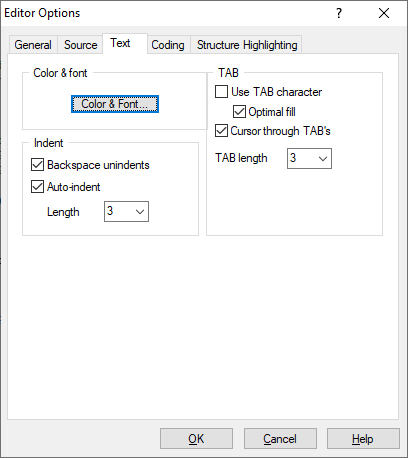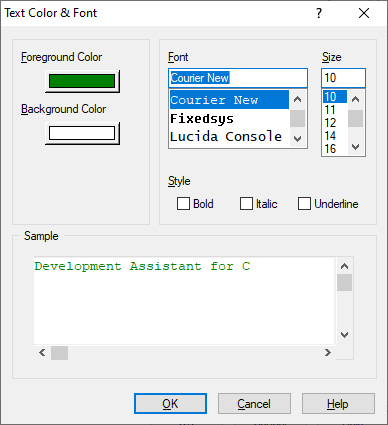General
This tab specifies the general Editor parameters.
Read-only notify
Determines if you should be informed about read-only files by an appropriate dialog box or only by a remark within the status bar.
Force fixed window size
Determines if the initial size of the Editor will be set by the "Window Height" and "Window Width" parameters. If this check box has not been selected, the size of the Editor is determined by the operating system according to its algorithms.
Previous size
Determines if the size and position of Editors will be remembered (after closing the Editor), and used for initial size and position of Editors for that file.
Editor's states buffered
After each change to the source file, the contents of the Symbols database, Message Logs, Browser, and so on will no longer reflect the current state in Editor, as the order of lines in the edited file will have changed. For example, if there is an error in the Message Logs which the analyzer has located in line 20, and two new lines are inserted before the line in question, the error will actually appear in line 22. Editor can mitigate this effect by registering all changes which bring about a change in line ordering. This option specifies the number of such changes which is to be registered - after this number, Editor no longer registers changes. A new analysis is considered necessary if this number of file changes is exceeded.
Save kills Undo
Determines if "File > Save" will destroy all Undo information.
Undo limit
Determines the maximum number of Undo operations that can be performed using the "Edit > Undo" menu command. Only the most recent "Undo Limit" operations can be undone.
Make backup file
Determines if the backup of the file in the Editor will be created while saving the file to the disk. The backup file has the original file name with the .BAK extension appended.
Insert mode
Determines if the starting edit state of the Editor will be Insert or Overwrite.
Persistent blocks
Determines which type of marking blocks will be used in Editor. If this check box is selected, marked blocks will remain selected until deleted or unmarked, or until another block is selected. This means that typed or pasted text is added at the insertion point position, instead of the contents of the selection being deleted. When this check box is cleared, if you move the insertion point after a block has been selected, the text does not stay selected.
Remove trailing spaces
Determines if the white spaces at the end of the line will be removed.
Show line numbers
This option enables or disables the line number display on the left margin of the window. The font size is automatically adjusted based on the current font size in the Editor. Line numbers are truncated to 5 least significant digits.
Smart line ends
If Smart line ends is on, DA-C tries to distinguish (based on file content) which combination of CR/ LF, CR, LF or LF/CR to put at the end of line.
EOL mark
EOL Mark sets the CR/LF combination if the Smart line ends parameter is off, or the new file has been edited.
Cursor beyond EOF
Determines if the text insertion point will move beyond the last line of the file.
Brief cursor
Determines if the shape of the text insertion point will correspond to the Brief text insertion point.
Auto-save time
The Auto-save feature periodically saves changes to disk to avoid substantial loss of data that could otherwise result from software malfunction, a power failure, or other minor malfunction. This entry sets the inactivity interval that will trigger Auto-save. Enter the desired number of minutes here. Zero value turns Auto-save off.
Auto-reload on file alert
Determines if a file in the Editor gets automatically reloaded (without asking) when changed outside DA-C Editor.







 Copyright © 1993-2022, RistanCASE PR
Copyright © 1993-2022, RistanCASE PR